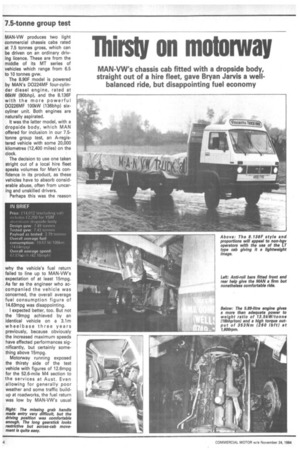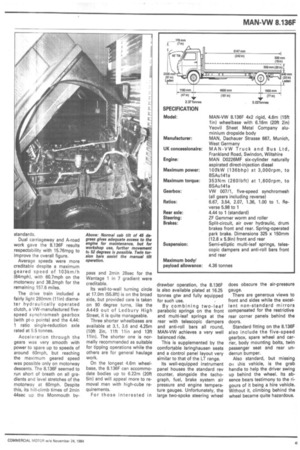irsty on motorway MAN-VW's chassis cab fitted with a dropside
Page 46

Page 51

If you've noticed an error in this article please click here to report it so we can fix it.
body, straight out of a hire fleet, gave Bryan Jarvis a wellbalanced ride, but disappointing fuel economy
MAN-VW produces two light commercial chassis cabs rated at 7.5 tonnes gross, which can be driven on an ordinary driving licence. These are from the middle of its MT series of vehicles which range from 6.5 to 10 tonnes gvw.
The 8.90F model is powered by MAINI's D0224MF four-cylinder diesel engine, rated at 66kW (90bhp), and the 8.136F with the more powerful D0226MF 100kW (136bhp) sixcyliner unit. Both engines are naturally aspirated.
It was the latter model, with a dropside body, which MAN offered for inclusion in our 7,5tonne group test, an A-registered vehicle with some 20,000 kilometres (12,400 miles) on the clock.
The decision to use one taken stright out of a local hire fleet speaks volumes for Man's confidence in its product, as these vehicles have to absorb considerable abuse, often from uncaring and unskilled drivers.
Perhaps this was the reason why the vehicle's fuel return failed to line up to MAN-VW's expectation of at least 15mpg. As far as the engineer who accompanied the vehicle was concerned, the overall average fuel consumption figure of 14.63mpg was disappointing.
I expected better, too. But not the 19mpg achieved by an identical vehicle on a 3.1m wheelbase three years previously, because obviously the increased maximum speeds have affected performances significantly, but certainly something above 15mpg.
Motorway running exposed the thirsty side of the test vehicle with figures of 12.6mpg for the 52.6-mile M4 section to the services at Aust. Even allowing for generally poor weather and some traffic buildup at roadworks, the fuel return was low by MAN-VW's usual Dual carriageway and A-road work gave the 8.136F results respectability with 15.76mpg to improve the overall figure.
Average speeds were more creditable despite a maximum geared speed of 103km/h (64mph), with 60.7mph on the motorway and 38.2mph for the remaining 157.6 miles.
The drive train included a fairly light 280mm (11in) diameter hydraulically operated clutch, a VW-manufactured fivespeed synchromesh gearbox (with pt-o points) and the 4.44: 1 ratio single-reduction axle rated at 5.5 tonnes.
Acceleration through the gears was very smooth with power to spare up to speeds of around 60mph, but reaching the maximum geared speed was possible only on motorway descents. The 8.136F seemed to run short of breath on all gradients and level stretches of the motorway at 60mph. Despite this, its hill-climb times of 2min 44sec up the Monmouth by pass and 2min 28sec for the Wantage 1 in 7 gradient were creditable.
Its wall-to-wall turning circle at 17.0m (55.8ft) is on the broad side, but provided care is taken on 90 degree turns, like the A449 out of Ledbury High Street, it is quite manageable.
Three shorter wheelbases are available at 3.1, 3.6 and 4.25m (10ft 2in, lift llin and 13ft llin). The shorter one is normally recommended as suitable for tipping operations while the others are for general haulage work.
On the longest 4.6m wheelbase, the 8.136F can accommodate bodies up to 6.22m (20ft 51n) and will appeal more to removal men with high-cube requirements.
For those interested in drawbar operation, the 8.136F is also available plated at 16.25 tonnes gtw and fully equipped for such use.
By combining two-leaf parabolic springs on the front and multi-leaf springs at the rear with telescopic dampers and anti-roll bars all round, MAN-VW achieves a very well balanced ride.
This is supplemented by the comfortable lsringhausen seats and a control panel layout very similar to that of the LT range.
Its well-equipped instrument panel houses the standard rev counter, alongside the tachograph, fuel, brake system air pressure and engine temperature gauges. Unfortunately, the large two-spoke steering wheel does obscure gauge. the air-pressure There are generous views to front and sides while the excellent non-standard mirrors compensated for the restrictive rear corner panels behind the doors.
Standard fitting on the 8.136F also include the five-speed gearbox, spare wheel and carrier, body mounting bolts, twin passenger seat and rear underrun bumper.
Also standard, but missing oil this vehicle, is the grab handle to help the driver swing up behind the wheel. Its absence bears testimony to the rigours of it being a hire vehicle. Without it, climbing behind the wheel became quite hazardous.
































































































